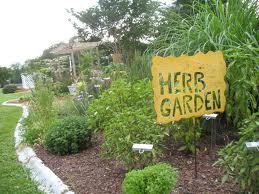Many novice cooks fret about what herbs to add to a recipe, when to add them and how much to add. There are no rules when cooking with herbs! The fun of livening up recipes with herbs is in the experimenting. For those who want more guidance, a guide is included indicating which herbs are good with which foods. Use this only as a guide. Experiment by adding a small amount of an herb or combinations of herbs to a dish, then taste. Add more if the flavor doesn’t suit you.
Add the herbs during the last 15-20 minutes of cooking. Certainly this cannot be done for recipes that require the herbs to be mixed in with the batter or dressing, for example. But for stews, vegetables and other recipes, adding herbs at the beginning of the cooking process diminishes the subtle flavor. Fresh herbs pack the most flavor. Gardeners can grow their own herbs and then preserve their harvest by either freezing or drying. Fresh herbs are available at local grocery stores and farmers markets. Dried herbs can be found at any grocery store.
If you don’t have a recipe, start with 1/4 teaspoon and add more as needed to reach your ideal flavor. You don’t want the herbs to overpower the other flavors in the dish. If a recipe calls for dried herbs, you can substitute fresh herbs. Dried herbs are stronger than fresh herbs so you will need to use more of the fresh herbs. If the recipe calls for 1 teaspoon of dried, crushed herbs or 1/4 teaspoon of powdered herbs, use 3 teaspoons (1 tablespoon) of fresh. If a recipe calls for fresh herbs, substitute dried herbs by decreasing the amount by half. When doubling a recipe, do not double the herbs or spices. Increase their amounts by 1 1/2. Remember, it is better to start with less and add more if desired.
Try using fresh herbs to add flavor while cutting back on fat, sugar and salt in recipes. Cooking with herbs also may have additional health benefits. Research is showing herbs have antioxidants which may help prevent cancer and heart disease. So, be adventurous and trying adding more herbs to some of your favorite recipes. Contact your local UF/IFAS Extension office for more information on growing or cooking with herbs.
Guide for Using Herbs:
Mint: Desserts, lamb, peas, fruit salads, sauces
Cilantro: Mexican and Asian cooking, rice, salsa, tomatoes
Sage: Cottage cheese, game meats, pork, rice, poultry, soups (chicken, minestrone, and vegetable), stuffing
Parsley: Salads, vegetables, pastas
Dill: Tomato dishes, yeast breads, eggs, coleslaw, potato salad, fish, beans, Brussels sprouts, cauliflower, cucumber, summer squash
Oregano: Tomato dishes, beef, game meats, veal, spaghetti, clams, soups (bean, minestrone, and tomato), beans, eggplant, and mushrooms
Rosemary: Dumplings, eggs, game meats, lamb, veal, poultry, fish, barbeque sauce, chicken, beef, soups (pea and vegetable), beans, mushrooms, potatoes, cauliflower, turnips
Thyme: Eggs, game meats, lamb, veal, rice, poultry, barbeque sauce, fish, oysters, chowders, soups (onion, tomato, and vegetable), mushrooms, tomatoes
Basil: Tomato products (juice, pasta sauces, pizza sauce, etc.), eggs, game meats, lamb, veal, rice, spaghetti, vinaigrette, soups (minestrone, pea, potato, and vegetable), beans, eggplant
RECIPE: Basil Pesto
- 2 cups fresh basil leaves, removed from stem
- 1/2 cup fresh parsley leaves
- 1/2 cup olive oil
- 2 garlic cloves, peeled
- Salt and freshly ground pepper to taste
- 1/4 cup roasted pine nuts
- 1/4 cup fresh Parmesan or Asiago cheese
In a blender or food processor, puree the basil, parsley, oil, garlic, salt, and pepper. Add the nuts and the cheese and process briefly until the pesto reaches the desired consistency. Makes 2 cups.
- Mental Health at Work: Prioritizing Well-Being in the Workplace - February 5, 2025
- Mental Health: It’s Your Job! - December 6, 2024
- Meet Your FCS Agent – Kendra Hughson - February 21, 2021

